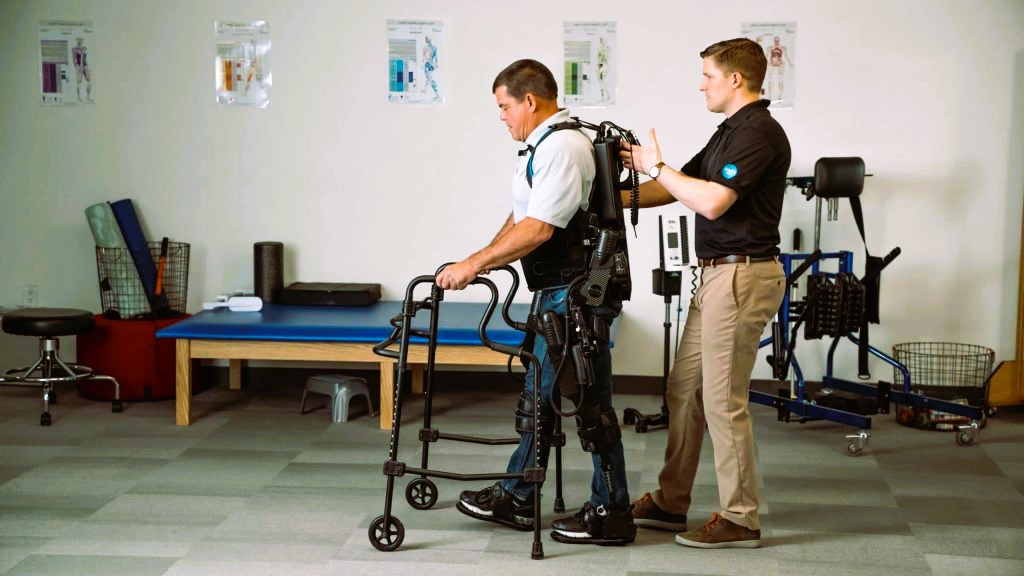Exoskeletons, once confined to the realm of science fiction, have now become a reality in the field of physical therapy, offering innovative solutions to enhance mobility, independence, and functionality for individuals with mobility impairments. These wearable robotic devices, which are worn externally and mimic the structure and function of the human skeleton, hold immense promise for assisting patients in rehabilitation and everyday activities. This article explores the applications of exoskeletons in physical therapy and their role in supporting mobility and functionality.
Understanding Exoskeletons in Physical Therapy
Exoskeletons are wearable robotic devices that augment or restore movement in individuals with musculoskeletal or neurological impairments. These devices typically consist of a framework of rigid or semi-rigid segments, actuated joints, sensors, and control algorithms that enable users to move their limbs with external assistance. Exoskeletons can be customized to fit the user’s anatomy and functional needs, providing powered assistance, resistance, or stabilization to specific joints or muscle groups.
In physical therapy, exoskeletons serve as assistive devices or therapeutic tools to support mobility, gait training, and rehabilitation. By providing external support and assistance to weakened or impaired limbs, exoskeletons enable individuals to perform activities of daily living, participate in therapy sessions, and improve their overall quality of life.
Applications of Exoskeletons in Physical Therapy
Exoskeletons have diverse applications in physical therapy practice, including:
- Gait Training and Rehabilitation: Exoskeletons are used to facilitate gait training and rehabilitation for individuals with mobility impairments due to stroke, spinal cord injury, traumatic brain injury, multiple sclerosis, and other neurological or musculoskeletal conditions. These devices provide external support and assistance to the lower limbs, enabling patients to stand up, walk, and practice overground walking with reduced effort and improved stability.
- Muscle Strengthening and Motor Recovery: Exoskeletons can be programmed to provide resistance or assistance during therapeutic exercises, such as sit-to-stand transfers, squatting, and stair climbing. By targeting specific muscle groups and controlling movement parameters, exoskeletons help individuals improve muscle strength, endurance, and coordination, facilitating motor recovery and functional gains.
- Assistive Mobility Devices: Exoskeletons serve as assistive mobility devices for individuals with mobility impairments who are unable to walk independently or use traditional mobility aids such as walkers or wheelchairs. These devices enable users to stand up from a seated position, walk over short distances, navigate uneven terrain, and perform activities at home, work, or in the community with greater freedom and autonomy.
- Pain Management and Posture Correction: Exoskeletons can be used to alleviate musculoskeletal pain, reduce joint compression, and improve posture by providing external support and alignment to the spine, pelvis, and lower limbs. By offloading weight-bearing joints and promoting proper biomechanics, exoskeletons help individuals maintain optimal body alignment and reduce the risk of musculoskeletal injuries during movement and weight-bearing activities.
Impact on Mobility and Functionality

The integration of exoskeletons into physical therapy practice has the potential to significantly impact mobility and functionality for individuals with mobility impairments:
- Improved Mobility: Exoskeletons enable individuals with mobility impairments to stand up, walk, and perform functional activities with greater ease and independence. By providing powered assistance to weakened or impaired limbs, exoskeletons enhance mobility and reduce the physical effort required to perform daily tasks, improving overall quality of life.
- Enhanced Rehabilitation Outcomes: Exoskeleton-assisted gait training and therapeutic exercises promote motor recovery, muscle strengthening, and functional gains in individuals undergoing rehabilitation. By providing targeted assistance and feedback during movement, exoskeletons facilitate neuroplasticity, motor learning, and retraining of gait patterns, leading to improved walking ability and independence. 3D printing in orthopedic rehabilitation, we have collected the most individual solutions for patients.
- Increased Participation in Daily Activities: Exoskeletons empower individuals with mobility impairments to participate more fully in activities of daily living, social interactions, and community engagement. By enabling users to stand, walk, and interact with their environment at eye level, exoskeletons promote social inclusion, psychological well-being, and participation in meaningful activities outside of the home or clinical setting.
Challenges and Considerations
Despite the potential benefits of exoskeletons in physical therapy, several challenges and considerations must be addressed to maximize their effectiveness and accessibility:
- Cost and Affordability: Exoskeletons are often expensive and may not be covered by health insurance or accessible to individuals with limited financial resources. Efforts to reduce costs, increase affordability, and explore funding options are needed to ensure equitable access to exoskeleton technology for all individuals who could benefit from it.
- User Training and Education: Effective use of exoskeletons requires training, education, and ongoing support for both users and therapists. Training programs should address device operation, safety precautions, maintenance, and troubleshooting, as well as strategies for integrating exoskeleton-assisted activities into daily life and rehabilitation programs.
- Customization and Personalization: Exoskeletons must be customized to fit the user’s anatomy, functional abilities, and rehabilitation goals to ensure optimal performance and user satisfaction. Clinicians should consider individual factors such as body size, weight, strength, range of motion, and cognitive abilities when selecting and adjusting exoskeleton parameters for each user.
Conclusion
Exoskeletons have the potential to revolutionize physical therapy practice by supporting mobility, functionality, and independence for individuals with mobility impairments. From gait training and rehabilitation to assistive mobility and posture correction, exoskeletons offer innovative solutions to address the diverse needs of patients across the lifespan.
For further information on the standardization of exoskeleton technologies in healthcare, visit Wikipedia’s page on Exoskeleton.
As exoskeleton technology continues to evolve and become more accessible, physical therapists have an opportunity to leverage these innovative devices to optimize rehabilitation outcomes, improve quality of life, and empower individuals with mobility impairments to achieve their full potential in mobility and functionality. By embracing exoskeletons as part of a comprehensive approach to physical therapy, therapists can enhance patient-centered care, promote independence, and facilitate meaningful participation in daily activities and social interactions.




